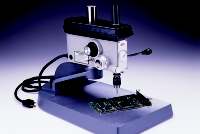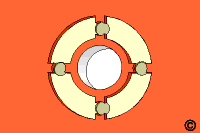No. 4.3.4
Deleting Inner Layer Connection at a Plated Hole, Spoke
Cut Method
OUTLINE
This procedure covers the repair of a damaged hole that has no inner layer
connection. An eyelet is used to repair the damage to the hole and the eyelet
flanges replace the pads on the circuit board surface.
CAUTION
This procedure is used only to restore the integrity of a through connection in
a double sided board or a multilayer board where there is no inner layer
connection. If there is an inner layer connection see appropriate procedure.
TOOLS & MATERIALS
Cleaner
Color Agent
Continuity Meter
End Mills
Epoxy
Microscope
Oven
Pin Clamps
Precision Drill System
Tape, Kapton
Wipes
PROCEDURE
- Identify the hole that requires rework and clean the area.
- Mark the coordinates on the board surface and place the circuit board on the base
plate of the precision drill press. (See Figure 1).
- Select the appropriate size end mill or drill and insert it into the chuck
of the Precision Drill System. The cutting tool should be approximately .010 -
.025 mm (.005" - 010") greater than the width of the spoke or circuit
to be cut. Set speed to high.
CAUTION
Abrasion operations can generate electrostatic charges.
NOTE
End mills are normally single end, 2 or 4 flute solid carbide.
- Mill into the circuit board surface adjacent to the plated hole. The milled holes
should be aligned directly above the internal spoke connections. Mill down just
deep enough to sever the internal spokes connecting the plated hole to the
internal plane. A microscope must be used for accuracy. Up to 4 milled holes may
be required. Do not drill deeper than needed. (See Figure 3).
- Blow away material with air and clean the area
- Check continuity to be sure that the internal connection has been deleted.
Inspect the neighboring circuits to make sure that none of them have been
severed or damaged.
- Mix the epoxy.
- Fill the holes with epoxy flush with the surface. Remove excess.
NOTE
A slight overfill of epoxy may be desired to allow for shrinkage.
- Cure the epoxy per Procedure 2.7 Epoxy Mixing and Handling.
EVALUATION
- Visual and electrical examination as required.
|
|
|
Solutions Across the Board
TM
|
|
|
|
Product Class: R/F
Skill Level: Expert
Conformance Level: High
Revision: E
Revision Date: Jul 7, 2000
Repair Service Charge

Deleting Inner layer Connection at a Plated Hole,
Spoke Cut Method

Figure 1: Precision Drill System with base plate to pin circuit board in position
while cutting inner layers.

Figure 2: Internal view of plated through hole with inner layer spoke
connections.

Figure 3: Mill adjacent to the plated hole to sever internal spoke connections.
|
Tricks of the Trade
A challenging operation made a bit easier when using a
Precision Drill System. End mills as small
as .010" may be required to make the spoke cuts.
|
Real Problems, Real Solutions
How do your correct a 4 layer circuit board that has both the
power and ground planes connected to the same plated-through holes? This was the
challenge presented to Circuit Technology Center. This design defect was not
detected until 450 circuit boards were fabricated. Simply drilling out the
defective plated-through hole was not acceptable because it would have broken
the proper connection. Also drilling out the hole would have removed the
plated-hole wall. The rework completed by Circuit Technology Center involved
drilling out the 4 spoke connections as described above. A Precision Drill
System fitted with a .010" diameter end mill was used. The circuit boards
were valued at $40 each. Rework charge was $16 per board. Total
Value $18,000 - Total Charge $7,200 = Total Savings $10,800
|
|
|





